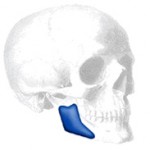
Infection from any type of facial implant is possible but is really quite uncommon. The risk is probably 1% or less. Jaw angle implants are placed beneath the thick masseter muscles and the jaw bone, both of which have a great blood supply that completely surrounds the implant. Even if infection were to occur, I would reopen the implant pocket, clean off the implant thoroughly and reinserting it back into the same pocket. This is a sound approach that will solve the infection most of the time as long as they are smooth silicone rubber implants. Implants composed of porous materials, however, make it near impossible to rid the bacteria which are embedded in the irregular deep channels of the implants. Porous Jaw angle implants should be removed and replaced at a later date.
Jaw implants are unique from cheek and chin implants because they are positioned under the big jaw chewing muscles. The motion of the jaw and the masseter muscle makes their displacement possible, and very likely if they are not rigidly secured into place. This displacement or movement of the implant will be toward and through the incision in the mouth that was used to place them. Extrusion of the implants can be solved by their repositioning and screw fixation to the bone. Often jaw angle implants displace because the pocket into which they were placed was not large enough or extended to the edge of the jaw bone. Pocket expansion and screw fixation can solve this problem.
Asymmetry or differences between the two sides of the jaw after surgery is another potential complication. Even when the implants are the same size (which is most common), jaw asymmetry can be seen after surgery. This is most commonly due to subtle differences in the two jaw sides that existed prior to surgery, which have only become ‘unmasked’ now that the jaw angles are larger. A good photographic and computer analysis can spot this potential problem beforehand. Differences in implant position can also account for this problem. If the asymmetry is significant enough, changing an implant’s size or position on the bone needs to be done.
Size concerns (too big or too small) is usually not as likely a postoperative problem as that of cheek or chin implants. It is very uncommon to have jaw angle implants that are too big. That is because the off-the-shelf or stock implants that are available are not that big and jaw bones are big. That combination does not make for a result that is too large. The result is most often a moderate change on each side which, because it is done to both sides, creates a nice effect that is not overdone.
Revisions of problematic jaw angle implants with a satisfactory outcome can usually be done by changing the size and shape of the implant or repositioning it with more secure fixation to the bone.
Dr. Barry Eppley
Indianapolis, Indiana


